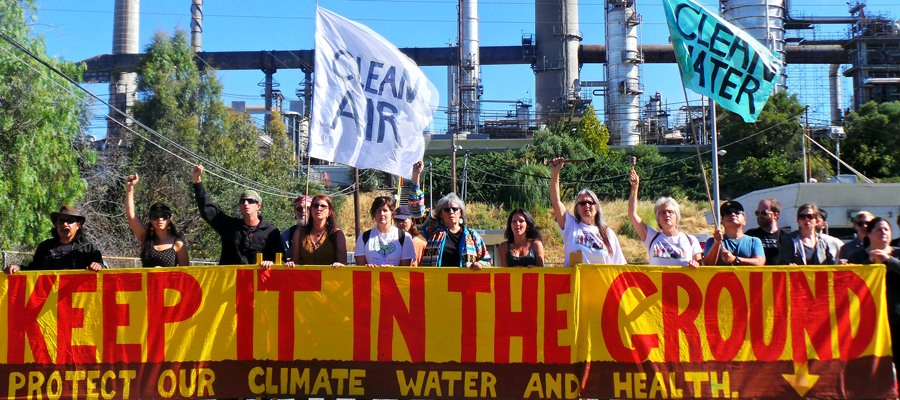A critical guide to the Pan-Canadian Framework on Clean Growth and Climate Change

After working on climate and energy issues intensively for the past nine years, I would love to scream from the rooftops about how Canada now has a real climate framework, and how as a nation we are proudly, if belatedly, walking the talk. Instead, I feel immensely disappointed by last week’s First Ministers’ Meeting on climate change both in terms of its limited outcomes, as well as the media focus on the politics of getting to a deal rather than the substance of the deal itself.
The Pan-Canadian Framework on Clean Growth and Climate Change is a positive step, but we needed a leap. That the federal, provincial and territorial governments (less Saskatchewan and Manitoba) came to agreement is indeed “historic”, but the resulting framework (“plan” is too generous a term) lacks the urgency called for by climate science, and fails to confront the entrenched power of the fossil fuel industry.
The Pan-Canadian Framework lacks the urgency called for by climate science, and fails to confront the entrenched power of the fossil fuel industry.
If you were expecting a list of new climate actions, the framework is a let down. For the most part it repeats measures already announced prior to the First Ministers’ Meeting: a phase-out of coal for electricity generation, a national carbon pricing floor, and regulations to reduce methane leakages. Most of the remainder lacks specifics or is left unfunded, some elements are punted to future negotiations, and it includes a lot of hand-waving about technology.
Targets and Timelines
First of all, the framework falls short of its own 2030 target. Forget the talk of “meeting or exceeding” Canada’s pledge of a 30% emissions reduction below 2005 levels by 2030; the framework does not even get to the 30% target set by the Harper government. In the coming months, we will need some independent modelling to give us a better handle on emission reductions. At this point there is only a single figure near the back of the agreement showing (without any transparency about how it was derived) estimated reductions from provincial plans to-date (including carbon offsets/credits) and new federal initiatives (mostly coal phase-out), but leaving a gap of 44 million tonnes to be filled by “additional measures”.
Many climate activists were hoping to see Canada up its game because that 2030 target is itself insufficient relative to the targets of the Paris Agreement, which aims for a maximum of 1.5 to 2°C of warming. Alas, the sum total of pledges made by signatories to the agreement adds up to a 3°C warmer world, which may not sound like much of a difference but is considered catastrophic. At some point countries will be called on to table more ambitious targets, but even this may be several years away.
We can only hope the current batch of initiatives will turn the corner and at least start Canada on a path of lowering emissions each year. Since 2000, Canada’s emissions profile has been relatively flat, with reductions from the phase out of coal-fired power in Ontario (down 37 million tonnes (Mt)) and the Maritimes (down 7 Mt), but offset by the growth in emissions from fossil fuel production (up 33 Mt) and transportation (up 15 Mt).
Fossil Fuel Expansion and Infrastructure
Days before the First Ministers Meeting, the federal government announced its approval of both Kinder-Morgan’s Trans Mountain Expansion and Enbridge’s Line 3 replacement and expansion. Back in October it approved the massive Pacific NorthWest LNG plant proposed for the BC coast.
Forget “meeting or exceeding”: the framework does not even get to the 30% emissions reduction target set by the Harper government.
In spite of being the source of one-quarter of Canada’s GHG emissions, the framework gives the oil and gas industry a pass. An exception to this is a commitment to reduce methane leakages by 40-45% (below 2012 levels) and to eliminating fossil fuel subsidies by 2025 – commitments Canada made with the US and Mexico in summer 2016. Basically, the growth of the oil and gas sector is taken for granted, and there are no measures to keep carbon in the ground.
The inconsistency of the climate framework with the push for pipelines is a good segue to First Nations issues.
The framework gushes participation and inclusion for Canada’s Indigenous people: the term “Indigenous” comes up 83 times, possibly the most-used term in the framework (the term “fossil fuels” appears a mere seven times). At the outset, it even speaks of “free, prior and informed consent.”
While it is refreshing to see this recognition on paper, contrast that with politics-as-usual in the context of the Kinder-Morgan pipeline decision. The Tsleil-Waututh First Nation—whose traditional territory lies at the terminus of the pipeline expansion—has consistently rejected the expansion due to likely negative impacts on their traditional way of life. These objections have been ignored by the federal government and are likely to form the basis of a legal challenge. More broadly, the September 2016 Treaty Alliance against Tar Sands Expansion includes signatories from more than 100 First Nations and tribes in the US and Canada, and is “an expression of Indigenous Law prohibiting the pipelines/trains/tankers that will feed the expansion of the Alberta Tar Sands.”
Modest Carbon Pricing
For all of the media attention it’s gotten, carbon pricing is a minor point in the framework. Because all of the large provinces already have (or will have) a carbon tax or cap-and-trade system in place by the 2018 implementation of a national carbon price floor, only a few smaller provinces are affected. All revenues collected by the federal government will be returned to the emitting province to do with as they see fit.
The carbon price floor is very low, starting at $10 per tonne (2.3 cents per litre at the pump) in 2018 and only starts to become more meaningful by 2022 when it rises to $50 (11.5 cents per litre). BC was a holdout at the 11th hour of the negotiations, and essentially won an out from carbon tax increases (above its current $30 per tonne, or 6.7 cents per litre) after 2020.
Compare this to the existing “price on carbon” in the form of fuel taxes, ranging from 6.2 cents per litre (equal to $26.5 per tonne of CO2) in the Yukon to 19.2 cents per litre ($82 per tonne) in Quebec. Even Brad Wall’s Saskatchewan effectively has a $64/tonne carbon price via its fuel taxes. We could also compare increased prices from the carbon tax to the price of gas back in 2014. Canadians have experienced much higher prices at the pump in the recent past than this carbon tax will impose in the future. The feds probably could have made this easier by just announcing an increase in the fuel tax and using it for infrastructure.
Canadians have experienced much higher prices at the pump in the recent past than this carbon tax will impose in the future.
On the cap-and-trade side, purchases of carbon credits/offsets from other jurisdictions, rather than compelling domestic emission reductions, are highly problematic. Ontario and Quebec are looking to buy credits from California and Mexico to partly meet their obligations. While they often sound good in theory, offsets have a bad reputation because they can be gamed by insiders through dubious accounting methodologies and sometimes outright fraud. In this sense BC Premier Clark may have been on to something: if Ontario and Quebec end up buying cheap and potentially bogus carbon credits to meet their obligations, why should BC impose a carbon tax?
Lack of Clarity on Other Actions
More meaningful actions seem to have been delayed or sidelined in the framework. I reported on the federal-provincial working groups over the summer, and noted that some of the most promising actions came in the Specific Mitigation Opportunities working group, which had a 19-page appendix with some detailed recommendations. Most of that got junked in favour of vague statements about improving energy efficiency and investing in technology. Measures affecting large industrial emitters are conspicuous by their absence.
For emission reductions from buildings and transportation, leaders punted. A model “net zero energy ready” building code will be developed, to start in 2030, and for existing buildings a model code will be developed by 2022. Energy efficiency and fuel switching are slated for existing buildings, although no funding commitment has been made to support it (a renewal of the federal ecoEnergy program, for example).
Another punt is in transportation, an area representing another quarter of Canada’s GHG emissions. The framework calls for “increasingly stringent standards for emissions” and the development of a Canada-wide strategy for zero-emission vehicles by 2018. Public transit expansion and upgrades are mentioned, but how much money is on the table is not clear. As with other infrastructure, the incremental investment from the federal government in 2016, though above what would have occurred had the Conservatives been re-elected, is actually very modest in the near-term. It’s also inadequate relative to the size of Canada’s economy and the infrastructure deficit that has emerged after more than two decades of austerity.
Indeed, progress is clouded by the federal objective of creating an “infrastructure bank”, which would finance, among other things, “clean electricity systems” (specifically mentioned in the framework). In theory, such a bank could allow the federal government to pool borrowing for provinces and municipalities, so they would pay a lower rate on new green investments. Instead, the federal pitch puts institutional investors like pension funds in the driver’s seat, and will only fund large projects that can charge user fees or tolls. The catch is that pension funds expect 6-9% annual returns compared to the 2% interest cost if funds were simply borrowed by Ottawa. This route will make the transition more expensive than it needs to be.
Final Thoughts
It’s almost cliché these days to note that climate action is not a technical problem, but a political one – so perhaps this is just the best we can do politically right now given the power of vested interests and the complexities of Canadian federalism. In light of developments south of the border, we are bound to look good in comparison.
Which brings us to the issue of climate change adaptation, a concession that we have collectively failed to constrain carbon emissions. The framework speaks to adaptation, although much of it comes down to major infrastructure investments. Again, action requires financial commitment on the part of governments.
Long-term, I’m actually pretty optimistic about the economics of renewables, and that we will eventually get to a clean energy economy. However, the central issue is how much damage we cause in the interim by dragging our feet. A year after the Paris Agreement, we still have a long way to go. We will all need to keep pushing to fill in the spaces of the pan-Canadian framework with investments and policies that drive down emissions, create green jobs and transform our economy.
Topics: Climate change & energy policy, Environment, resources & sustainability, Fracking & LNG


